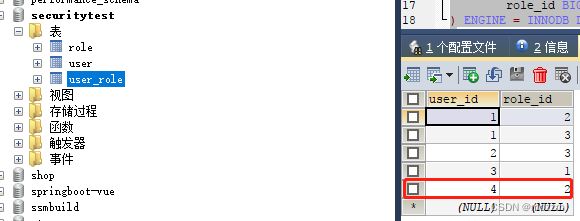springboot整合springsecurity
接着上篇博客springboot整合springsecurity,本次主要是对其进行了优化
首先需要建立三张表,分别是user, role, user_role
创建表的时候特别需要注意:在创建role角色的时候,一定要按照 "ROLE_xxx"这种格式来写,这是security的规范,不然不会生效。
DROP TABLE IF EXISTS `user`;
DROP TABLE IF EXISTS `role`;
DROP TABLE IF EXISTS `user_role`;
CREATE TABLE `user` (
id INT PRIMARY KEY AUTO_INCREMENT,
`name` VARCHAR(10),
`password` VARCHAR(10)
) ENGINE = INNODB DEFAULT CHARSET = utf8;
CREATE TABLE `role` (
id INT PRIMARY KEY AUTO_INCREMENT,
`name` VARCHAR(10)
) ENGINE = INNODB DEFAULT CHARSET = utf8;
CREATE TABLE `user_role` (
user_id BIGINT(10),
role_id BIGINT(10)
) ENGINE = INNODB DEFAULT CHARSET = utf8;
INSERT INTO `user`(`name`,`password`) VALUES('zhangsan','123456');
INSERT INTO `user`(`name`,`password`) VALUES('lisi','123456');
INSERT INTO `user`(`name`,`password`) VALUES('wangwu','123456');
INSERT INTO `user`(`name`,`password`) VALUES('赵六','123456');
INSERT INTO `role`(`name`) VALUES('ROLE_VIP1');
INSERT INTO `role`(`name`) VALUES('ROLE_VIP2');
INSERT INTO `role`(`name`) VALUES('ROLE_VIP3');
INSERT INTO `user_role`(`user_id`,`role_id`) VALUES(1,2);
INSERT INTO `user_role`(`user_id`,`role_id`) VALUES(1,3);
INSERT INTO `user_role`(`user_id`,`role_id`) VALUES(2,3);
INSERT INTO `user_role`(`user_id`,`role_id`) VALUES(3,1);user是用户表,role是角色表,通过user_role将两张表建立联系
创建好数据库之后,创建项目
pom文件:
4.0.0
com.atguigu
springboot-05-security
0.0.1-SNAPSHOT
jar
springboot-05-security
Demo project for Spring Boot
org.springframework.boot
spring-boot-starter-parent
1.5.12.RELEASE
UTF-8
UTF-8
1.8
3.0.9.RELEASE
2.3.0
3.0.2.RELEASE
org.thymeleaf.extras
thymeleaf-extras-springsecurity4
org.springframework.boot
spring-boot-starter-thymeleaf
org.springframework.boot
spring-boot-starter-security
org.springframework.boot
spring-boot-starter-web
org.mybatis.spring.boot
mybatis-spring-boot-starter
2.1.0
mysql
mysql-connector-java
javax.persistence
persistence-api
1.0
org.projectlombok
lombok
org.springframework.boot
spring-boot-starter-test
test
org.springframework.boot
spring-boot-maven-plugin
然后创建application.yml文件,完成数据库相关配置
spring:
datasource:
driver-class-name: com.mysql.jdbc.Driver
username: root
password: root
url: jdbc:mysql://localhost:3306/securitytest?useUnicode=true&characterEncoding=utf-8&useSSL=false&serverTimezone=GMT
创建实体类:users, role
package com.example.security.entity;
import lombok.Data;
import javax.persistence.Table;
@Data
@Table(name = "user")
public class Users {
private int id;
private String name;
private String password;
}
package com.example.security.entity;
import lombok.Data;
import javax.persistence.Table;
@Data
@Table(name = "role")
public class Role {
private int id;
private String name;
}
创建mapper: userMapper, roleMapper
package com.example.security.mapper;
import com.example.security.entity.Users;
import org.apache.ibatis.annotations.Select;
public interface UserMapper {
@Select("select * from user where name = #{name}")
Users loadUserByUsername(String name);
}
package com.example.security.mapper;
import com.example.security.entity.Role;
import org.apache.ibatis.annotations.Select;
import java.util.List;
public interface RoleMapper {
@Select("SELECT r.`name` FROM role r WHERE r.id IN (SELECT role_id FROM user_role s inner JOIN `user` u ON s.`user_id` = u.`id` and u.id = #{id})")
List findRoleByUserId(int id);
}
创建service: userService 继承UserDetailsService,
package com.example.security.service;
import org.springframework.security.core.userdetails.UserDetailsService;
public interface UserService extends UserDetailsService {
}
实现类
package com.example.security.service.Impl;
import com.example.security.entity.Role;
import com.example.security.entity.Users;
import com.example.security.mapper.RoleMapper;
import com.example.security.mapper.UserMapper;
import com.example.security.service.UserService;
import org.springframework.security.core.authority.SimpleGrantedAuthority;
import org.springframework.security.core.userdetails.User;
import org.springframework.security.core.userdetails.UserDetails;
import org.springframework.security.core.userdetails.UsernameNotFoundException;
import org.springframework.stereotype.Service;
import javax.annotation.Resource;
import java.util.ArrayList;
import java.util.List;
@Service
public class UserServiceImpl implements UserService {
@Resource
private UserMapper userMapper;
@Resource
private RoleMapper roleMapper;
@Override
public UserDetails loadUserByUsername(String name) throws UsernameNotFoundException {
try {
//获取用户信息,如果没有用户信息直接返回
Users users = userMapper.loadUserByUsername(name);
if(users == null){
return null;
}
List authorityList = new ArrayList<>();
List roles = roleMapper.findRoleByUserId(users.getId());
for(Role role: roles){
authorityList.add(new SimpleGrantedAuthority(role.getName()));
}
UserDetails userDetails = new User(users.getName(),users.getPassword(),authorityList);
return userDetails;
}catch (Exception e){
e.printStackTrace();
return null;
}
}
}
最后配置类:
package com.example.security.config;
import com.example.security.service.Impl.UserServiceImpl;
import org.springframework.beans.factory.annotation.Autowired;
import org.springframework.security.config.annotation.authentication.builders.AuthenticationManagerBuilder;
import org.springframework.security.config.annotation.web.builders.HttpSecurity;
import org.springframework.security.config.annotation.web.configuration.EnableWebSecurity;
import org.springframework.security.config.annotation.web.configuration.WebSecurityConfigurerAdapter;
@EnableWebSecurity
public class SecurityConfig extends WebSecurityConfigurerAdapter {
@Autowired
private UserServiceImpl userServiceImpl;
@Override
protected void configure(HttpSecurity http) throws Exception {
//super.configure(http);
//定制请求的授权规则
http.authorizeRequests().antMatchers("/").permitAll()
.antMatchers("/level1/**").hasRole("VIP1")
.antMatchers("/level2/**").hasRole("VIP2")
.antMatchers("/level3/**").hasRole("VIP3");
//开启自动配置的登陆功能,效果,如果没有登陆,没有权限就会来到登陆页面
http.formLogin().usernameParameter("user").passwordParameter("pwd")
.loginPage("/userlogin");
//1、/login来到登陆页
//2、重定向到/login?error表示登陆失败
//3、更多详细规定
//4、默认post形式的 /login代表处理登陆
//5、一但定制loginPage;那么 loginPage的post请求就是登陆
//开启自动配置的注销功能。
http.logout().logoutSuccessUrl("/");//注销成功以后来到首页
//1、访问 /logout 表示用户注销,清空session
//2、注销成功会返回 /login?logout 页面;
//开启记住我功能
http.rememberMe().rememberMeParameter("remember");
//登陆成功以后,将cookie发给浏览器保存,以后访问页面带上这个cookie,只要通过检查就可以免登录
//点击注销会删除cookie
}
//定义认证规则
@Override
protected void configure(AuthenticationManagerBuilder auth) throws Exception {
// //super.configure(auth);
// auth.inMemoryAuthentication()
// .withUser("zhangsan").password("123456").roles("VIP1","VIP2")
// .and()
// .withUser("lisi").password("123456").roles("VIP2","VIP3")
// .and()
// .withUser("wangwu").password("123456").roles("VIP1","VIP3");
auth.userDetailsService(userServiceImpl);
}
}
最后启动类:
package com.example.security;
import org.mybatis.spring.annotation.MapperScan;
import org.springframework.boot.SpringApplication;
import org.springframework.boot.autoconfigure.SpringBootApplication;
@SpringBootApplication
@MapperScan("com.example.security.mapper")
public class SecurityApplication {
public static void main(String[] args) {
SpringApplication.run(SecurityApplication.class, args);
}
}
最终结果:
可以看到,用户名为赵六,密码123456,对应的数据库信息如下:id为4,再通过user_role表查看id为4对应的role_id,结果为2,查看role表,id为2时对应的角色为VIP2,对应的是学生,结果正确




